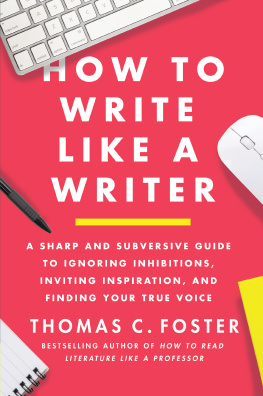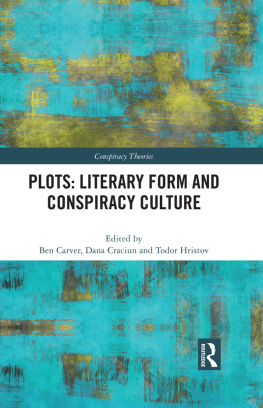Thomas C. Foster
Contents
Novel Possibilities, or All Animals Arent Pigs?
Once Upon a Time: A Short, Chaotic, and Entirely Idiosyncratic History of the Novel
Pickup Lines and Open(ing) Seductions, or Why Novels Have First Pages
You Cant Breathe Where the Air Is Clear
Whos in Charge Here?
Never Trust a Narrator with a Speaking Part
A Still, Small Voice (or a Great, Galumphing One)
Men (and Women) Made out of Words, or My Pip Aint Like Your Pip
When Very Bad People Happen to Good Novels
Wrinkles in Time, or Chapters Just Might Matter
Everywhere Is Just One Place
Clarissas Flowers
Met-him-pike-hoses
Life Sentences
Drowning in the Stream of Consciousness
The Light on Daisys Dock
Fiction About Fiction
Source Codes and Recycle Bins
Read with Your Ears
Improbabilities: Foundlings and Magi, Colonels and Boy Wizards
Whats the Big Ideaor Even the Small One?
Who Broke My Novel?
Untidy Endings
History in the Novel/The Novel in History
Conspiracy Theory
: The Never-Ending Journey
: Criticism of the Novel
Novel Possibilities, or All Animals Arent Pigs?
W HEN H UCK AND J IM are floating south on their raft, where are we? How is it that we can identify with a being as monstrous, literally, as John Gardners Grendel? Have you ever been Lucy Honeychurch? Leopold Bloom? Humbert Humbert? Tom Jones? Bridget Jones? The novels we read allow us to encounter possible persons, versions of ourselves that we would never see, never permit ourselves to become, in places we can never go and might not care to, while assuring that we get to return home again. At the same time, the novel holds out its own possibilities, narrative miracles, and tricks that are rewards in themselves, seductions for unsuspecting and even canny readers.
Much of the continuing appeal of the novel lies in its collaborative nature; readers invest themselves in the characters stories, becoming actively involved in the creation of meaning. At the same time, they are rewarded by pleasures that are more intimate than the essentially vicarious genres of drama and film. That give-and-take between creator and audience starts in the first line, runs through the last word, and causes the novel to stay in our minds long after we close the cover.
And it is a real give-and-take. The novel begs to be read from its opening words, tells us how it would like to be read, suggests things we might look for. We readers decide whether well go with the program, even whether well read the book or not. We decide whether we agree with the author about whats important, we bring our understanding and imagination to bear on characters and events, we involve ourselves not merely in the story but in all aspects of the novel, we collude in the creation of meaning. And we carry the book with us and keep it alive, sometimes centuries after the author himself is dead. Active and engaged reading is critical to the life of the novel and rewarding and fulfilling in the life of the reader.
In 1967, the novel was in a bad way, or so it seemed. Two seminal essays by writers with distressingly similar names appeared in American publications, fortelling doom and gloom. The French critic and philosopher Roland Barthes published an essay called The Death of the Author in the journal Aspen . In that essay, Barthes places the whole responsibility for the construction of meaning and significance, that is to say the interpretive enterprise, on the reader, the writer (whom he prefers to call a scriptor) being little more than a conduit through which the accumulated culture pours its texts . Barthes is being more than a little impish in denying the author the quasi-divine author ity he was accorded in earlier understandings of literary creation. But what he is chiefly supporting is the role of active and creative reading, something about which we will have occasion to discuss throughout the book. Perhaps more alarmingly, the American novelist John Barth published The Literature of Exhaustion in The Atlantic Monthly , in which he seemed to many readers to suggest that the novel was on its deathbed. What he in fact argued was that the novel as we had known it was pretty largely played out, the exhaustion of the essays title referring to exhausted possibilities. Fiction, he suggested, was going to have to find something new to do in order to reinvigorate itself. There was a lot of talk of the death of old ways in 1967, a lot of emphasis on newness, its signature event being the accumulation of outrageous humanity around the intersection of Haight and Ashbury streets in San Francisco.
What Barth seemed not to know (although with him, a lot of seeming is disingenuous) was that help was on the way. That same year, a novel was being published by a writer in Colombia and another was being composed by a writer in England, and they would offer ways forward from the apparent impasse. The English novelist John Fowles was composing The French Lieutenants Woman , possibly the first major commercial novel to seriously address changes in the landscape of fictional theory. At the beginning of Chapter 13, he says of his faux-historical novel that it cannot be a conventional Victorian novel despite its outward appearance as such because I live in the age of Alain Robbe-Grillet and Roland Barthes. Instead, the novel teases readers with Victorian characters and settings even as it reminds them that it is a fictional, twentieth-century work that is merely employing Victorian conventions for its own ends. The literary gamesmanship did not harm sales; The French Lieutenants Woman was the best-selling novel in America in 1969. The Colombian novel was, of course, Gabriel Garca Mrquezs One Hundred Years of Solitude , which would appear in English three years later. The solution it offered was not one of metafictional play but of the wild eruption of the fabulous amidst the commonplace, what would become known as magic realism. These works and writers changed everything, so much so that Barth returned to The Atlantic in 1979 with an essay called The Literature of Replenishment, in which he admitted things had changed more in a dozen years than he could have foreseen and that maybe, just maybe, this novel thing did have a future. He cites Garca Mrquez and Italo Calvino in particular as reinvigorating the form. So what does it mean to say that they changed everything? Did everyone begin copying what they did? No, even they didnt copy what they did. There is only one One Hundred Years of Solitude , and even Garca Mrquez cant write a second one. But those novels showed possibilities in the form that had not been tried in quite the same way before, things a writer might do with fiction that would be sufficiently new and interesting to keep readers hanging around.
I believe, moreover, that the essays and the novels in question show something else: the history of the genre. The novel is always dying, always running out of steam, and always being renewed, reinvented. We might say, following the philosopher Heraclitus, one cannot step in the same novel twice. To stay put is to stagnate. Even those novelists we value for their samenessCharles Dickens, George Eliot, Ernest Hemingwayare constantly changing and growing. They move, if only slightly, from one novel to the next; they set themselves new challenges. Those who stand pat soon seem stale, flat, and unprofitable. As it is with individual writers, so it is with the form itself. The movement is neither inevitably forward nor backward; progress in matters literary is chiefly an illusion. But movement there is and movement there must be. In a genre called novel, readers have some right to expect novelty. Thats only fair, isnt it?














